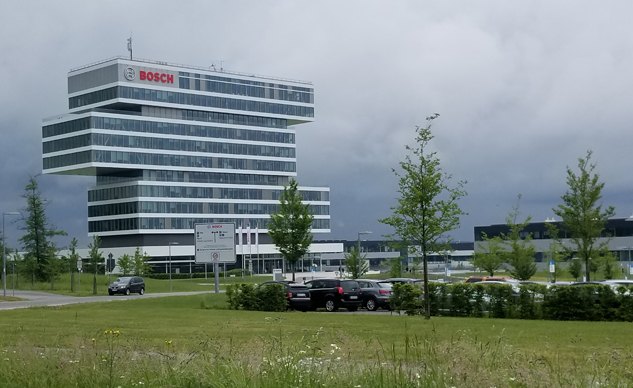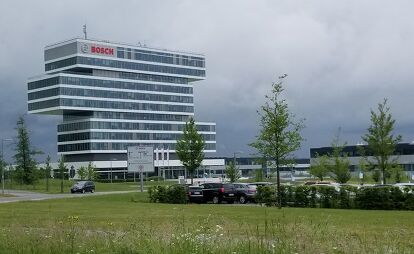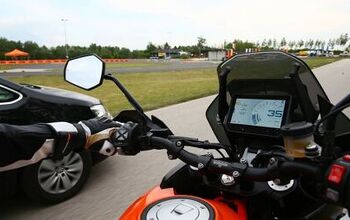Bosch Rider Assistance Technology Continues to Advance

We visit Bosch's Renningen-based research facility to sample some new tech
As motorcyclists, we may have a different outlook when we hear the name Bosch. I know I do, but to many, the name may conjure up familiarities with automotive parts, household appliances, or power tools. The German technological powerhouse plays more of a role in our lives than the average consumer may ever be aware of, from sensors and software in your car, to the toaster on your counter, there’s a good chance you use the company’s tech and may not even be aware of it. Of course, I’m not really in the business of writing about toasters so, for now, we’ll focus on Bosch’s technological advancements for motorcycling and most importantly, a few new pieces of technology that we should be seeing on the market within two to three years.
Approximately 18 hours after leaving the Orange County airport, I found myself as one of two U.S. journalists in Stuttgart, Germany for a release of new rider assistance technology from Bosch. Of course, you’ve likely already read about this information, as Bosch decided to release all of the info they would be presenting to us and to the entire world the same day we received our presentation. Seems like an odd PR decision, but okay.
At this point, we had mostly been kept in the dark as to any specific details to what “rider assistance technology” meant in this specific situation, but it wasn’t difficult to speculate. Try as I might to eek out information at our welcome dinner, the Bosch employees dining with us stayed tight-lipped as to what we would be learning about the next day. Of course, that wasn’t so bad because I got to chop it up with the head of Bosch’s Two-Wheel & Powersport Business Unit, Geoff Liersch, sharing stories about ill-fated off-road excursions and the like. It became clear quickly during dinner with marketing staff, engineers, and executives from the company that the folks in the Two-Wheel & Powersports unit of Bosch are passionate motorcycle enthusiasts. From Liersch’s stories of wrangling livestock with a motorcycle in the bush of Australia as a child, to the engineers mentioning the Two-Wheel & Powersport Unit’s annual trackdays, there is an enthusiasm and genuine passion for driving technology in the two-wheel segment.
For those of you who may be unaware, Bosch has a substantial stake in not only the automotive industry, but also the motorcycle industry. Globally, Bosch has 250 dedicated two-wheel and powersport employees, most of which are engineers. Although 250 may be dedicated exclusively to the group, at times, as many as 1000 Bosch employees can be found working to support the unit in its initiatives.
The company manufactures sensors, control units, batteries, and software, among other things, for motorcycling. In 2013, Bosch brought us cornering ABS and Motorcycle Stability Control with the release of the 2014 KTM Adventure 1190 (of which I am a satisfied owner) and has expanded the technology to many OEMs who have adopted the technology since. Come to think of it, there’s a Bosch logo underneath the tail section on my tech-heavy ’15 Tuono as well.
The engineers we spoke with referred to Bosch’s current technology on the market as building blocks for the future of rider assistance, mentioning that it was important to use development motorcycles that had fully adopted the previous tech in order to have the best platform to build on. This explains its choice of the 2018 KTM 1290 Super Adventure S with Bosch-equipped cornering ABS and motorcycle stability control (MSC) as a prototype platform which we would have the chance to ride.
The new rider assistance tech we would be sampling the following day had been thoroughly tested by nearly all of the Bosch employees involved in development. Liersch himself had clocked over 2,500 km on the prototype units and cited 30 to 40,000 km tested in total on the bikes we would be riding.
The morning we woke to grab a quick breakfast and head to the research track near the Renningen headquarters. It was a gloomy day, accompanied by light spits of rain that would occasionally turn into full downpours. Of course, this hardly did anything to dampen our mood as we were all interested in what Bosch had in store for us later in the day. Geoff Liersch also mentioned the system worked fantastically in the rain as he had used it in Japan on his way to and from a very rainy Motegi MotoGP race in 2017.
After donning our riding gear and a brief presentation, we were let loose on the research track to test the two systems before hitting the autobahn for a real-world demonstration of how the systems could be used. My personal vehicle has three of the systems that we would test on the bikes, so I was looking forward to experiencing the tech applied to motorcycles.
Adaptive Cruise Control (ACC)
We’ve been seeing cruise control become more standard not only on touring motorcycles as of late, but also on 1000cc sportbikes and a number of naked motorcycles as well. Naturally, it would only be a matter of time before we would see adaptive cruise control on motorcycles.
I’ve driven my Ford Explorer across the country numerous times, and I thoroughly enjoy using the adaptive cruise. It’s interesting how lazy you become on long road trips, fussing about cars pulling in front of you and having to cancel the cruise control, albeit just a few buttons will have it back on easily.
We first tested the adaptive cruise control on the research track behind a car instructed to drive at a consistent 40 kph where we let the car have some distance and set the cruise control speed to a faster speed and watched the system work as we closed in on the car in front of us. I was able to take a few spins on the track to get a feel for how far out one would need to move in order to have the ACC begin to pick up speed for a passing maneuver – it was near perfectly half of what a normal lane might be which would provide ample room between the motorcycle and the vehicle it’s passing.
During my ride up to the Quail on the Triumph Tiger 1200, it would have been wonderful to have the adaptive cruise during the few times we came across light traffic on the 101 freeway. On the autobahn the ACC worked just as it should. The only complaints I had involved the speed at which the motorcycle accelerated back up because on the autobahn, speed differentials are a bit higher than what we typically encounter in the states. I had mentioned that I would prefer the system accelerated faster which the engineers assured me was an easily programmable change.
Speaking with the engineers and Geoff Liersch afterward, they informed me that many of the parameters are customizable to the specific preference of the OEMs who choose to adapt the technology. Setting adjustments such as adjustable following distance and acceleration speeds are options that manufacturers can tweak or include for certain markets where driving habits can differ. Bosch’s aim with all of its technology is to provide the basic idea and to let the manufacturer have a highly customizable platform to include the systems on motorcycles as they see fit.
Frontal Collision Warning and Blind Spot Detection
As much as I have enjoyed using the adaptive cruise in my Ford Explorer, I absolutely despise the frontal collision warning, which often sets itself off during times when it’s completely unnecessary. With the radar-based system being used for adaptive cruise control by Bosch, it would be a no-brainer to include a frontal collision warning as it is just software at this point with the sensors already in place.
We tested the frontal collision warning on the research track while following the same car from our previous demonstration and were instructed to simply drive at a higher speed toward the car and wait for the warning. Of course, that was counter-intuitive to what you normally do as we would be accelerating toward the car, then looking down at the dash to see the warning. If you can’t already tell, the setup in which we tested the frontal collision warning was not what I would call ideal.
After voicing my concerns that the warning on the TFT display was out of my peripheral vision while looking ahead, the engineers jokingly told me that if I was looking ahead, I wouldn’t need the warning. True, but the only time one would see this warning is if you are staring at your display, maybe fiddling with suspension settings or ride modes. Again, as these technologies are meant to be highly customizable to be able to adapt to many different manufacturers, the frontal collision warning system can be set as a visual, audible, or haptic warning, which I believe the latter two will be more practical for application.
The next step in this technology would be priming the braking system or actively braking for the rider which Bosch says is the next iteration they are exploring. That one makes me a tad nervous to imagine as the Explorer has this option, and again, it has proven to be too sensitive at times. The application into two-wheeled vehicles will be a difficult one for Bosch, but there are plenty of people working on these ideas that are much smarter than me. So, we’ll wait and see.
The radar-based systems also used side and rearward sensors to give a blindspot indication to the rider of an upcoming vehicle to the sides. Likely spots for this indication will be lights in the mirrors as are standard on many cars, of course this is again, up to the manufacturer.
eCalling
Bosch also shared with us technology that they see as three to five years out before being commercially available, such as emergency calling. As of March 31, 2018 eCalling is mandatory on all new automobiles sold in the EU. Bosch participated in a public-funded study to consider the application to motorcycles as well, which I believe most of us would agree, is perhaps more important for motorcyclists as it is easier to have an accident and leave the roadway without passer-bys noticing there has been an incident.
The application to motorcycles includes specific challenges to be sure the system works properly without error. Motorcyclists are prone to push the limits of their ride, messing about with wheelies, stoppies, burnouts, etc. which could cause a system to be triggered if these possibilities aren’t taken into considerations. Bosch has put in the time and research to effectively limit the erroneous situations in which the eCall could be triggered. Also of consideration is the potential of low-speed get-offs or accidental tip-overs that likely don’t need emergency services. This has been mitigated with a period of time where the eCall is triggered yet remains blinking for a predetermined amount of time before using the data collected from various sensors to be sent into an emergency contact database to dispatch the necessary services to your specific location via GPS.
Other, less critical software, could also be implemented to allow for what Bosch calls bCall (breakdown calling) and iCall (information calling) to help make motorcyclists lives easier when faced with issues on the road.
Jet Repulsion
This is where things turned a bit futuristic. With MSC and cornering ABS already used in production motorcycles, Bosch is continuing its research into safety intervention in sudden friction loss while cornering. Bosch looks at this technology as five to ten years out, if it becomes commercially available at all.
According to Bosch’s study of 500 active (2,000+ km per year) riders, 83% percent perceive friction loss while cornering as dangerous or very dangerous while 5% of these riders had already experienced a low/high side. As one might expect, participants in this survey were highly in favor of a system to better mitigate traction loss situations and, rightfully so, with another Bosch study showing 60% of motorcycle accidents involve curves.
Bosch went to work to develop a system it would call Sliding Mitigation by Repulsion. The idea behind this is that once traction is lost either front or rear, the missing tire force is compensated by a gas generator of some sort deploying, which then creates a lateral repulsion force to help the tire mitigate the traction lost.
We were able to watch a video as well as a live demonstration of the rather crude initial application to better illustrate the idea. In the video, the motorcyclist can be seen riding over a large gravel patch with outriggers attached to the bike to prevent an actual crash. The first time through, the rider loses the front with the steering being forced all the way to the lock as traction is lost. Slow motion is used to fully appreciate the loss of traction. We then see the repulsion system used in real time and slow motion, in which it’s visually clear that the intervention correlates to the lack of movement at the front wheel. It may be a ways out from a practical application, but any invention has to start somewhere.
Get the Flash Player to see this player.
The Bosch Group is a leading global supplier of technology and services, employing roughly 402,000 associates worldwide (as of December 31, 2017) and generating sales of 78.1 billion euros in 2017. As motorcyclists, we should be thankful to have a company of Bosch’s stature providing and advancing technology in the motorcycle industry. Bosch plans to have the adaptive cruise control, frontal collision warning, and blind spot indication available on select 2020 model year Ducati and KTM motorcycles.

Ryan’s time in the motorcycle industry has revolved around sales and marketing prior to landing a gig at Motorcycle.com. An avid motorcyclist, interested in all shapes, sizes, and colors of motorized two-wheeled vehicles, Ryan brings a young, passionate enthusiasm to the digital pages of MO.
More by Ryan Adams




























































































Comments
Join the conversation
It is good to see a company working on tech like this for motorcyclists. Working on an outrigger-equipped bike is much different than a regular single-track vehicle, but it's a start. Adaptive cruise control on a bike, wow. Autonomous vehicles can exist with motorcycles, glad to see companies like Bosch doing the work and R&D. Also happy that I can actually comment on this article. Cycle World's site has been closing the comment sections on a number or articles, ones that are still new. The one about Roland Sands FXR project, closed. Their own write-up on this subject, closed. First we get coffee-table quarterlies and no more letters from readers, now we can't even talk about and comment on the articles. I enjoy reading others ideas and opinions (even when different than mine), and I learn from those that are smarter than I am or have more or different experiences. Thank you for still allowing me to express my gratitude and offer my own experiences/thoughts in the comment sections. Plus, a lot of people that post here are hilarious! I know I can get a great laugh from some of the regulars, which keeps me coming back.
Don’t want!!! I just bought a new car with adaptive cruise and lane keep, automatic breaking, etc and I’ve found these technologies to do literally NOTHING but distract me at critical moments when driving and make my vehicle behave erratically. I do NOT want a computer making any decisions for me while I ride. That’s why I’m riding in the first place instead of droning along in my computer-I-mean-car. Nope. Also, in my experience, Bosch tech is terrifyingly buggy and prone to failure.